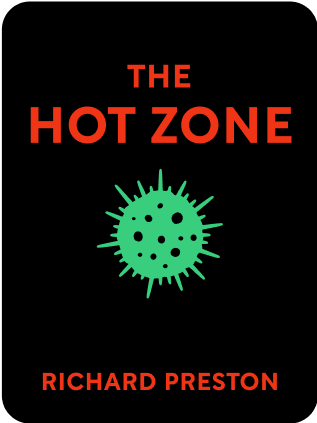

This article is an excerpt from the Shortform summary of "The Hot Zone" by Richard Preston. Shortform has the world's best summaries of books you should be reading.
Like this article? Sign up for a free trial here .
What are Ebola symptoms in humans? What are the signs and symptoms of Ebola?
Ebola has several strains, and the symptoms can vary. But Ebola symptoms in humans do share some commonalities, and all are considered highly deadly.
Read more about Ebola symptoms in humans.
Ebola Symptoms in Humans
Read about the symptoms for two Filovirus diseases, Marburg and Ebola Zaire.
Marburg Virus
Marburg’s kill rate among patients treated in hospitals is about 1 in 4, which makes Marburg an extremely lethal virus. By comparison, yellow fever’s kill rate is about 1 in 20, and it is considered highly lethal.
Marburg virus attacks organs, intestines, skin, and connective tissue throughout the body. Its Ebola symptoms in humans include:
- Extensive bruising
- Blood clots throughout the body, from organs to extremities
- Hemorrhages from every orifice
- Black vomit, a mixture of arterial blood and black specks that indicate hemorrhage
- Impaired central nervous system
- Destroyed brain, leading to personality changes, memory loss, and an expressionless face
- Swollen testicles in male victims
- Peeling skin on survivors’ faces, hands, feet, and genitals during recovery
The virus is extremely virulent and highly infective, and it can live in corpses’ eyeballs for months after death.
(Shortform note: Besides the kill rate, there are no major identifiable differences between Marburg and Ebola. Scientists don’t know why Ebola is deadlier than Marburg.)
Marburg’s kill rate among patients treated in hospitals is about 1 in 4, which makes Marburg an extremely lethal virus. By comparison, yellow fever’s kill rate is about 1 in 20, and it is considered highly lethal.
Marburg virus attacks organs, intestines, skin, and connective tissue throughout the body. Its Ebola symptoms in humans include:
- Extensive bruising
- Blood clots throughout the body, from organs to extremities
- Hemorrhages from every orifice
- Black vomit, a mixture of arterial blood and black specks that indicate hemorrhage
- Impaired central nervous system
- Destroyed brain, leading to personality changes, memory loss, and an expressionless face
- Swollen testicles in male victims
- Peeling skin on survivors’ faces, hands, feet, and genitals during recovery
The virus is extremely virulent and highly infective, and it can live in corpses’ eyeballs for months after death.
(Shortform note: Besides the kill rate, there are no major identifiable differences between Marburg and Ebola. Scientists don’t know why Ebola is deadlier than Marburg.)
Ebola Zaire
Ebola Zaire shares many signs and symptoms of Ebola with other filoviruses, but Ebola Zaire is the most aggressive of the filoviruses, digesting all the organs and tissues in victims’ bodies until they liquefy into a slime of replicated virus particles. This is one of the best known Ebola symptoms in humans.
This is how Ebola Zaire affects different parts of victims’ bodies:
Blood
- Blood clots start to clog the bloodstream, getting stuck on the walls of blood vessels and in capillaries, which cuts off blood supply to different areas of the body.
- Sections of brain, breast tissue, intestines, kidneys, liver, lungs, skin, and testicles begin to die from lack of blood supply.
- All the body’s coagulation factors (proteins that allow blood to clot) are used up internally—causing the excessive blood clots—while the blood that leaves the body can’t clot, simply bleeding incessantly.
- Victims bleed from the mouth, including around the teeth and salivary glands.
- The eyeballs fill with blood, sometimes causing blood to run from them like tears, and potentially causing blindness.
Skin
- Hemorrhages under the skin create visible red spots, which quickly spread to become large bruises.
- Skin collagen breaks down, causing the layers beneath the skin to liquefy, causing tiny white blisters to appear on the skin.
- The skin becomes fragile, easily tearing off and ripping. The surfaces and linings of the tongue, back of the throat, and windpipe also shed.
Organs
- The heart hemorrhages, filling the heart chambers and chest cavity with blood in one of the Ebola symptoms in humans.
- The intestines fill with blood, while their lining sheds and is excreted.
- Blood clots cause the kidneys to fail, at which point the blood becomes contaminated with urine.
- The liver becomes swollen and yellow, then liquefies, and finally dies and rots while the victim is still alive.
- The spleen hardens into a massive blood clot.
- Many of the organs begin dying and dissolving before the victim is dead.
Brain
- Dead blood cells clog the brain. Some victims suffer hemispherical strokes, paralyzing one side of the body.
- Victims often suffer grand mal seizures, during which their entire body convulses. The seizures cause the blood that is hemorrhaging from every orifice to splatter around the area. Seizures typically happen in the final stages, and the blood splatter gives the virus a chance to jump to a new host before its current host dies.
After death, the body continues to liquefy, oozing fluids that are packed with virus particles.
These are the symptoms of Ebola symptoms in humans. Though the signs and symptoms of Ebola can vary depending on the strain, they’re all considered a highly deadly disease.

———End of Preview———
Like what you just read? Read the rest of the world's best summary of Richard Preston's "The Hot Zone" at Shortform .
Here's what you'll find in our full The Hot Zone summary :
- The many different strains of Ebola, including the deadliest kind with a kill rate of 90%
- How scientists unraveled the mystery of a new strain of Ebola
- How Ebola could become airborne, becoming one of the deadliest viruses known






